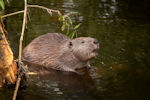Maryland Fur Trappers
Maryland's FurbearersProtecting and Preserving Our Ecosystem for Future Generations Since 1961
For All Who Love Maryland’s Beautiful Outdoors – Meet Maryland’s Furbearers
In the heart of Maryland, where emerald forests meet the gentle embrace of the Chesapeake Bay, a tale unfolds beneath the towering oaks and alongside the meandering rivers. The state’s natural beauty paints a picturesque canvas, with rolling hills and vibrant wildflowers that dance in the breeze.
Amidst this lush landscape, a diverse array of furbearers find their haven. Sly red foxes stealthily navigate the underbrush, their russet coats blending seamlessly with the autumn foliage. In the shadows, elusive bobcats tread lightly, guardians of the wooded realms.
Beside the sparkling waters, the sleek river otters playfully dart through the shallows, their playful antics echoing the joyous spirit of the region. Bald eagles soar majestically overhead, their keen eyes surveying the landscape below, while beavers diligently construct their intricate lodges along the banks.
As the seasons unfold, Maryland’s natural wonders take on different hues. Winter blankets the land in a quiet serenity, with snow-laden branches creating a serene backdrop for the deer that gracefully traverse the snow-covered meadows. Spring breathes new life into the landscape, with blossoming dogwoods and cherry trees adorning the scenery.
Residents and visitors alike revel in the charm of Maryland, cherishing the delicate balance between the state’s natural beauty and the thriving furbearer populations. The harmony of the ecosystem echoes in the rustling leaves and babbling brooks, a testament to the enduring enchantment of Maryland’s wild heart.
Meet Our Furbearer Residents
Maryland’s diverse ecosystems are home to an array of fur-bearing species, each playing a vital role in the state’s ecological balance. Take a quick look into the habits, reproductive traits, habitat requirements, ecology, and life cycles of prominent fur bearers in Maryland, including beaver, bobcat, coyote, fisher, grey fox, longtailed weasel, mink, muskrat, nutria, opossum, raccoon, red fox, river otter, and skunk.

Beaver (Castor canadensis):
- Habit: Semi-aquatic, beavers construct dams and lodges.
- Reproduction: Monogamous pairs, kits born in spring.
- Habitat: Freshwater habitats with access to wood for dam construction.
- Ecology: Keystone species, influencing wetland formation and biodiversity.

Bobcat (Lynx rufus):
- Habit: Solitary and elusive, with nocturnal tendencies.
- Reproduction: Solitary, with kittens born in spring.
- Habitat: Diverse, ranging from forests to swamps.
- Ecology: Top predator, regulating small mammal populations.
Coyote (Canis latrans):
- Habit: Highly adaptable, coyotes thrive in various environments.
- Reproduction: Monogamous pairs, pups born in spring.
- Habitat: Diverse habitats, including forests, fields, and urban areas.
- Ecology: Key predator, impacting prey populations and maintaining ecosystem balance.
Fisher (Pekania pennanti):
- Habit: Solitary and agile, fishers prefer forested areas.
- Reproduction: Delayed implantation, kits born in late winter.
- Habitat: Dense forests, especially coniferous, for denning and hunting.
- Ecology: Carnivorous, controlling small mammal populations.
Grey Fox (Urocyon cinereoargenteus):
- Habit: Climbers with retractable claws, grey foxes navigate trees.
- Reproduction: Monogamous pairs, kits born in spring.
- Habitat: Woodlands and brushy areas, providing escape routes.
- Ecology: Omnivores, contributing to seed dispersal.
Long-Tailed Weasel (Mustela frenata):
- Habit: Small and slender, with excellent climbing abilities.
- Reproduction: Solitary, with kits born in late spring.
- Habitat: Varied, from woodlands to fields.
- Ecology: Predatory, controlling rodent populations.
Mink (Neovison vison):
- Habit: Semi-aquatic carnivores, minks are skilled swimmers.
- Reproduction: Monogamous pairs, kits born in late spring.
- Habitat: Riparian zones and wetlands.
- Ecology: Efficient hunters, controlling small mammal and bird populations.
Muskrat (Ondatra zibethicus):
- Habit: Semi-aquatic, muskrats build lodges in wetlands.
- Reproduction: Breeding occurs year-round, with kits born in spring.
- Habitat: Wetlands and freshwater habitats.
- Ecology: Herbivores, shaping wetland vegetation through feeding and burrowing.
Nutria (Myocastor coypus):
- Habit: Semi-aquatic, with large, webbed hind feet.
- Reproduction: Prolific breeders, with multiple litters annually.
- Habitat: Wetlands and marshes.
- Ecology: Invasive species, impacting wetland vegetation.
Opossum (Didelphis virginiana):
- Habit: Arboreal and terrestrial, opossums are nocturnal.
- Reproduction: Solitary, with pouches for carrying and protecting young.
- Habitat: Diverse environments, from forests to urban areas.
- Ecology: Opportunistic feeders, playing a role in scavenging.
Raccoon (Procyon lotor):
- Habit: Highly adaptable omnivores, raccoons thrive in urban and rural areas.
- Reproduction: Solitary, with kits born in early summer.
- Habitat: Varied habitats, including forests, urban areas, and wetlands.
- Ecology: Opportunistic feeders, influencing insect and small mammal populations.
Red Fox (Vulpes vulpes):
- Habit: Opportunistic omnivores, red foxes adapt well to various environments.
- Reproduction: Monogamous pairs, kits born in early spring.
- Habitat: Varied habitats, including forests, grasslands, and urban areas.
- Ecology: Efficient hunters, impacting rodent populations.
River Otter (Lontra canadensis):
- Habit: Excellent swimmers, river otters inhabit aquatic environments.
- Reproduction: Delayed implantation, with pups born in late winter.
- Habitat: Rivers, lakes, and wetlands.
- Ecology: Apex predators, maintaining aquatic ecosystem health.
Skunk (Mephitis mephitis):
- Habit: Nocturnal, with potent defensive spray.
- Reproduction: Solitary, with kits born in spring.
- Habitat: Varied habitats, including woodlands, grasslands, and urban areas.
- Ecology: Omnivores, influencing insect and small mammal populations.
The fur bearers of Maryland contribute significantly to the state’s biodiversity and ecosystem health. Understanding their habits, reproductive traits, habitat requirements, and ecological roles is crucial for conservation efforts and maintaining a balanced and resilient natural environment.
As such, Maryland Fur Trappers is dedicated to preserving the state’s biodiversity and fostering a healthy ecosystem. Through responsible trapping practices, we contribute to wildlife management, controlling populations, safeguarding delicate ecosystems, and preventing disease.
Our commitment extends to conservation education, raising awareness about sustainable coexistence between humans and wildlife. We aim to enhance the natural environment, ensuring a balance that benefits both animals and their ecosystems.
Maryland Fur Trappers recognizes the interconnectedness of species and strives to be a steward of the environment, promoting harmony between human activities and the diverse wildlife that calls Maryland home.













